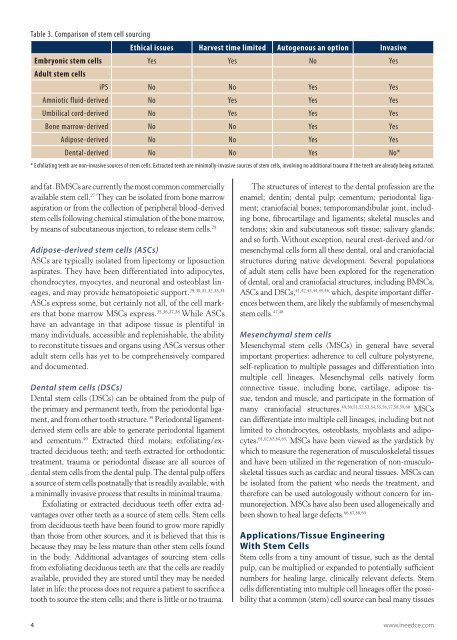Stem Cells: Sources, Therapies and the Dental ... - IneedCE.com
Stem Cells: Sources, Therapies and the Dental ... - IneedCE.com
Stem Cells: Sources, Therapies and the Dental ... - IneedCE.com
You also want an ePaper? Increase the reach of your titles
YUMPU automatically turns print PDFs into web optimized ePapers that Google loves.
Table 3. Comparison of stem cell sourcing<br />
Ethical issues Harvest time limited Autogenous an option Invasive<br />
Embryonic stem cells Yes Yes No Yes<br />
Adult stem cells<br />
iPS No No Yes Yes<br />
Amniotic fluid-derived No Yes Yes Yes<br />
Umbilical cord-derived No Yes Yes Yes<br />
Bone marrow-derived No No Yes Yes<br />
Adipose-derived No No Yes Yes<br />
<strong>Dental</strong>-derived No No Yes No*<br />
* Exfoliating teeth are non-invasive sources of stem cells. Extracted teeth are minimally-invasive sources of stem cells, involving no additional trauma if <strong>the</strong> teeth are already being extracted.<br />
<strong>and</strong> fat. BMSCs are currently <strong>the</strong> most <strong>com</strong>mon <strong>com</strong>mercially<br />
available stem cell. 27 They can be isolated from bone marrow<br />
aspiration or from <strong>the</strong> collection of peripheral blood-derived<br />
stem cells following chemical stimulation of <strong>the</strong> bone marrow,<br />
by means of subcutaneous injection, to release stem cells. 28<br />
Adipose-derived stem cells (ASCs)<br />
ASCs are typically isolated from lipectomy or liposuction<br />
aspirates. They have been differentiated into adipocytes,<br />
chondrocytes, myocytes, <strong>and</strong> neuronal <strong>and</strong> osteoblast lineages,<br />
<strong>and</strong> may provide hematopoietic support. 29,30,31,32,33,34<br />
ASCs express some, but certainly not all, of <strong>the</strong> cell markers<br />
that bone marrow MSCs express. 35,36,37,38 While ASCs<br />
have an advantage in that adipose tissue is plentiful in<br />
many individuals, accessible <strong>and</strong> replenishable, <strong>the</strong> ability<br />
to reconstitute tissues <strong>and</strong> organs using ASCs versus o<strong>the</strong>r<br />
adult stem cells has yet to be <strong>com</strong>prehensively <strong>com</strong>pared<br />
<strong>and</strong> documented.<br />
<strong>Dental</strong> stem cells (DSCs)<br />
<strong>Dental</strong> stem cells (DSCs) can be obtained from <strong>the</strong> pulp of<br />
<strong>the</strong> primary <strong>and</strong> permanent teeth, from <strong>the</strong> periodontal ligament,<br />
<strong>and</strong> from o<strong>the</strong>r tooth structure. 39 Periodontal ligamentderived<br />
stem cells are able to generate periodontal ligament<br />
<strong>and</strong> cementum. 40 Extracted third molars; exfoliating/extracted<br />
deciduous teeth; <strong>and</strong> teeth extracted for orthodontic<br />
treatment, trauma or periodontal disease are all sources of<br />
dental stem cells from <strong>the</strong> dental pulp. The dental pulp offers<br />
a source of stem cells postnatally that is readily available, with<br />
a minimally invasive process that results in minimal trauma.<br />
Exfoliating or extracted deciduous teeth offer extra advantages<br />
over o<strong>the</strong>r teeth as a source of stem cells. <strong>Stem</strong> cells<br />
from deciduous teeth have been found to grow more rapidly<br />
than those from o<strong>the</strong>r sources, <strong>and</strong> it is believed that this is<br />
because <strong>the</strong>y may be less mature than o<strong>the</strong>r stem cells found<br />
in <strong>the</strong> body. Additional advantages of sourcing stem cells<br />
from exfoliating deciduous teeth are that <strong>the</strong> cells are readily<br />
available, provided <strong>the</strong>y are stored until <strong>the</strong>y may be needed<br />
later in life; <strong>the</strong> process does not require a patient to sacrifice a<br />
tooth to source <strong>the</strong> stem cells; <strong>and</strong> <strong>the</strong>re is little or no trauma.<br />
The structures of interest to <strong>the</strong> dental profession are <strong>the</strong><br />
enamel; dentin; dental pulp; cementum; periodontal ligament;<br />
craniofacial bones; temporom<strong>and</strong>ibular joint, including<br />
bone, fibrocartilage <strong>and</strong> ligaments; skeletal muscles <strong>and</strong><br />
tendons; skin <strong>and</strong> subcutaneous soft tissue; salivary gl<strong>and</strong>s;<br />
<strong>and</strong> so forth. Without exception, neural crest-derived <strong>and</strong>/or<br />
mesenchymal cells form all <strong>the</strong>se dental, oral <strong>and</strong> craniofacial<br />
structures during native development. Several populations<br />
of adult stem cells have been explored for <strong>the</strong> regeneration<br />
of dental, oral <strong>and</strong> craniofacial structures, including BMSCs,<br />
ASCs <strong>and</strong> DSCs, 41,42,43,44,45,46, which, despite important differences<br />
between <strong>the</strong>m, are likely <strong>the</strong> subfamily of mesenchymal<br />
stem cells. 47,48<br />
Mesenchymal stem cells<br />
Mesenchymal stem cells (MSCs) in general have several<br />
important properties: adherence to cell culture polystyrene,<br />
self-replication to multiple passages <strong>and</strong> differentiation into<br />
multiple cell lineages. Mesenchymal cells natively form<br />
connective tissue, including bone, cartilage, adipose tissue,<br />
tendon <strong>and</strong> muscle, <strong>and</strong> participate in <strong>the</strong> formation of<br />
many craniofacial structures. 49,50,51,52,53,54,55,56,57,58,59,60 MSCs<br />
can differentiate into multiple cell lineages, including but not<br />
limited to chondrocytes, osteoblasts, myoblasts <strong>and</strong> adipocytes.<br />
61,62,63,64,65, MSCs have been viewed as <strong>the</strong> yardstick by<br />
which to measure <strong>the</strong> regeneration of musculoskeletal tissues<br />
<strong>and</strong> have been utilized in <strong>the</strong> regeneration of non-musculoskeletal<br />
tissues such as cardiac <strong>and</strong> neural tissues. MSCs can<br />
be isolated from <strong>the</strong> patient who needs <strong>the</strong> treatment, <strong>and</strong><br />
<strong>the</strong>refore can be used autologously without concern for immunorejection.<br />
MSCs have also been used allogeneically <strong>and</strong><br />
been shown to heal large defects. 66,67,68,69<br />
Applications/Tissue Engineering<br />
With <strong>Stem</strong> <strong>Cells</strong><br />
<strong>Stem</strong> cells from a tiny amount of tissue, such as <strong>the</strong> dental<br />
pulp, can be multiplied or exp<strong>and</strong>ed to potentially sufficient<br />
numbers for healing large, clinically relevant defects. <strong>Stem</strong><br />
cells differentiating into multiple cell lineages offer <strong>the</strong> possibility<br />
that a <strong>com</strong>mon (stem) cell source can heal many tissues<br />
4 www.ineedce.<strong>com</strong>

















